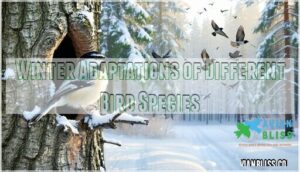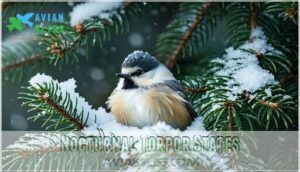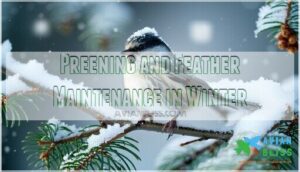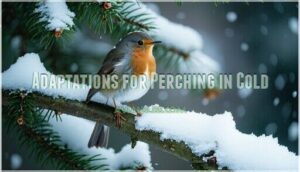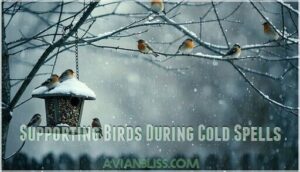This site is supported by our readers. We may earn a commission, at no cost to you, if you purchase through links.

When temperatures drop, you’ll notice birds fluffing their feathers to trap warm air, creating a cozy down jacket effect.
They shiver to generate heat, huddle together for warmth, and can even enter a mini-hibernation state called torpor to conserve energy.
Their feet have special blood vessels that prevent frostbite, while their beaks and bodies are designed to handle harsh conditions.
Some species can survive temperatures that would send you running for hot cocoa, making winter their playground.
Table Of Contents
- Key Takeaways
- Birds’ Physiological Responses to Cold Temperatures
- Winter Adaptations of Different Bird Species
- How Birds Maintain Warmth in Harsh Conditions
- Feeding Strategies for Winter Survival
- Risks and Challenges of Cold Weather
- Preening and Feather Maintenance in Winter
- Temperature Thresholds for Bird Discomfort
- Unique Adaptations of Birds’ Feet
- Flight and Cold Weather Interactions
- Supporting Birds During Cold Spells
- Frequently Asked Questions (FAQs)
- What temperature is too cold for birds?
- How do birds survive winter?
- How do you know if your bird is cold?
- How do birds not freeze their feet?
- How do migratory birds handle cold weather?
- Can birds sense approaching cold fronts?
- Do urban birds face different cold challenges?
- How does cold weather affect bird communication?
- Do birds change habitats when temperatures drop?
- Do baby birds survive cold weather differently?
- Conclusion
Key Takeaways
- You’ll notice birds do get cold, but they’re equipped with remarkable survival mechanisms like fluffing feathers to trap warm air, shivering to generate heat, and entering torpor states to conserve energy when temperatures drop below 50°F.
- You can help birds survive winter by providing high-energy foods like suet and sunflower seeds, offering unfrozen water sources through heated birdbaths, and creating shelter opportunities with roosting boxes or evergreen plantings.
- You’ll see different species use unique cold-weather strategies – chickadees huddle together and cache thousands of food items, woodpeckers create insulated roosting cavities, and grouse burrow into snow for protection from harsh conditions.
- You should understand that birds face serious risks when temperatures drop below 40°F, including hypothermia, wet feather damage that reduces insulation, and increased energy demands that can lead to starvation if food sources become scarce.
Birds’ Physiological Responses to Cold Temperatures
When you think about birds surviving freezing temperatures, their bodies automatically activate several internal systems to stay warm.
Birds can raise their core temperature, fluff their feathers to trap air, shiver to generate heat, and even slow their metabolism to save energy during the coldest conditions.
Body Temperature Regulation
When temperatures drop, birds become masters of avian thermoregulation, maintaining their core temperature around 105°F even in freezing conditions.
Birds are nature’s thermal engineers, cranking their internal furnaces to 105°F while winter rages around them.
You’ll find these remarkable creatures use several heat conservation strategies to avoid hypothermia risks.
Here’s how their metabolic processes work overtime:
- Shivering muscles generate extra body heat through rapid contractions
- Entering torpor lowers metabolism to conserve precious energy
- Adjusting blood flow redirects warmth to essential organs
- Increasing metabolic rate burns more fuel for internal heating
Their bird temperature regulation system puts our human heating to shame!
Feather Insulation
Understanding bird feather insulation reveals nature’s masterpiece.
Birds fluff their plumage to trap warm air between insulation layers, creating a personal heating system.
Down feathers work like thermal underwear, while outer feathers provide water repellency.
Preening importance can’t be overstated—it maintains feather structure for peak performance.
| Feather Type | Primary Function |
|---|---|
| Down feathers | Trap warm air for insulation |
| Contour feathers | Provide water repellency and structure |
| Flight feathers | Enable movement while maintaining warmth |
The primary function of these feathers is crucial for the birds’ survival, and the unique structure of down feathers allows them to trap warm air efficiently.
Shivering for Heat Generation
When cold temperatures trigger their shivering threshold, birds activate rapid muscle contractions to generate essential body heat through avian thermogenesis.
This bird shivering mechanism works like an internal furnace, though shivering intensity increases metabolic cost dramatically.
While effective for avian cold tolerance, prolonged shivering causes muscle fatigue.
These bird adaptations winter survival depends on help birds balance energy expenditure with bird body heat production during freezing conditions.
Metabolic Rate Adjustments
Birds crank up their internal engines when temperatures drop. Metabolic acclimation lets them boost energy expenditure by up to 40% through enhanced thermogenesis.
This avian physiology adjustment helps maintain ideal body temperature despite freezing conditions. Here’s how their metabolism adapts:
- Increased heart rate pumps warm blood faster throughout their bodies
- Enhanced cellular activity generates more heat through dietary thermogenesis
- Elevated breathing delivers oxygen for efficient energy production
- Torpor regulation conserves precious energy during harsh nights
Winter Adaptations of Different Bird Species
You’ll discover that different bird species have developed unique strategies to survive winter’s harsh conditions.
From chickadees that can remember thousands of hidden food locations to woodpeckers that create cozy roosting holes, each species uses specific adaptations that match their size, diet, and habitat needs.
Chickadees and Kinglets
Tiny powerhouses like Chickadees and Golden-crowned Kinglets showcase remarkable cold tolerance through specialized bird adaptations.
These masters of winter flocking demonstrate incredible avian physiology that defies their small size.
Chickadee huddling in communal roosts conserves precious energy, while their feather insulation creates protective air pockets.
Kinglet foraging continues even at -30°F as they search for insects with remarkable persistence.
Chickadees also rely on cached food stores to survive periods of scarcity.
Here’s how these champions survive:
- Metabolic magic: They lower body temperature several degrees to conserve energy
- Social strategy: Winter flocks share warmth and foraging knowledge
- Dietary needs: High-fat foods fuel their survival engines
Woodpeckers and Cavity-Nesting Birds
Woodpeckers master winter survival through their exceptional cavity-nesting abilities.
They excavate roosting cavities in rotting snags, choosing softer wood typically within six feet of the ground.
These bill adaptations allow them to access insect larvae and hibernating carpenter ants hidden beneath bark.
Smart snag selection creates perfect bird shelter winter refuges that shield them from harsh winds and freezing temperatures.
Multiple birds often share these cozy spaces, demonstrating remarkable bird behavior cooperation.
Their avian adaptations include returning to the same roost nightly, making these excavated homes essential for winter survival success.
Cavity-nesting
Grouse and Snow Burrowing
You’ve probably never imagined a Ruffed Grouse diving headfirst into snow for winter survival.
These remarkable birds create bird shelter winter hideouts through sophisticated burrowing mechanics:
- Predator avoidance – Snow caves hide grouse from hunters and foxes
- Energy conservation – Spending 80% of daylight resting reduces calorie needs
- Insulation properties – Snow conditions provide natural thermal protection for shelter
They also develop increased feather densities for warmth.
Crows and Communal Roosting
Thousands of crows create massive communal roosts during winter nights, transforming urban areas into avian gathering spots.
These intelligent birds select roost sites based on warmth, wind protection, and safety from predators.
While disease risk increases in large groups, roost benefits far outweigh dangers—shared body heat, enhanced security, and social bonding help these remarkable birds survive harsh winter conditions together.
| Roost Characteristics | Urban Roosts | Winter Benefits |
|---|---|---|
| Size ranges from hundreds to 50,000+ birds | Parks, parking lots, tall buildings | Shared body heat reduces energy loss |
| Selection based on wind protection | Street lights provide warmth and visibility | Group vigilance against predators |
| Temporary sites change seasonally | Human activity offers added security | Social learning and mate finding |
How Birds Maintain Warmth in Harsh Conditions
When you watch birds during winter storms, you’ll notice they use several clever techniques to stay warm that work together like a survival toolkit.
These methods include huddling with other birds, finding sheltered spots, entering energy-saving sleep states, and using simple tricks like standing on one leg to reduce heat loss, which are all crucial for their winter survival.
Huddling and Social Thermoregulation
You’ll often spot birds clustering together during winter storms, using huddling as their primary Group Warmth strategy.
This Social Behavior creates remarkable Energy Conservation through Cooperative Thermoregulation.
When birds face cold temperatures, huddling becomes essential for winter survival.
Here’s how this avian behavior provides Huddling Benefits:
- Shared body heat reduces individual energy expenditure
- Interior birds stay warmest while exterior birds rotate positions
- Communal roosting sites maximize thermal efficiency for survival
Seeking Shelter and Microhabitats
Beyond huddling together, you’ll find birds seeking shelter in natural alcoves and dense vegetation.
Tree crooks become perfect roosts, while cavity roosting in old woodpecker holes offers warmth. Dense evergreen trees shield against wind and snow.
Birds also discover manmade shelters like roost boxes you provide. These microhabitats create warmer pockets where temperatures stay several degrees higher than open areas, giving our feathered friends the edge they need.
Tree Cavities
Snow Burrows
Ground Cover
Nocturnal Torpor States
When shelter isn’t enough, many birds enter torpor – basically bird hibernation.
This remarkable energy savings strategy drops their metabolism and body temperature by up to 30°C.
Torpor duration varies dramatically, with hummingbirds using shallow energy stores for brief periods while nightjars maintain deep states all night.
Environmental triggers like food scarcity activate arousal mechanisms.
Species variation means chickadees might use torpor differently than kinglets, but all benefit from reduced energy demands.
One-Legged Standing Technique
You’ve probably noticed birds standing on one leg during winter.
This simple technique reduces heat conservation by 50% compared to standing on both feet.
Birds alternate legs to prevent muscle fatigue while maintaining perfect balance control.
Their specialized leg circulation system keeps blood flowing efficiently.
Their leg joints feature locking mechanisms, minimizing muscle fatigue.
Species variation affects this behavior:
- Waterfowl use it most frequently in cold water
- Songbirds employ it during harsh wind conditions
- Raptors utilize it while hunting in winter weather
Feeding Strategies for Winter Survival
When winter arrives, you’ll notice birds face a critical challenge: finding enough high-energy food to fuel their bodies and maintain warmth in freezing temperatures.
Birds must increase their daily calorie intake by up to 40% during cold months, switching to nutrient-dense foods like seeds, nuts, and cached insects while developing clever foraging techniques to locate food buried under snow.
High-Energy Food Sources
Survival depends on energy-rich foods that fuel birds through winter’s harsh grip.
You’ll notice birds seeking specific high-calorie options to maintain their body heat and energy reserves.
- Suet Benefits – Packed with fat, suet provides concentrated calories for sustained warmth
- Seed Variety – Sunflower seeds and nyjer offer essential oils and proteins
- Nutritious Berries – Natural fruit sources deliver quick energy bursts
- Winter Feeders – Consistent food sources support Caching Behavior for survival
To guarantee birds get enough nutrition, consider offering black oil sunflower seeds.
Foraging Techniques in Snow
When snow blankets the ground, you’ll witness remarkable snow foraging techniques that showcase birds’ resourcefulness.
Dark-eyed Juncos demonstrate classic subnivean access by performing their signature double-scratch hop, kicking backward with both feet to uncover hidden seeds beneath snow layers.
You’ll notice woodpeckers using specialized bill adaptations to probe tree bark for dormant insects, while nuthatches work headfirst down trunks with precision.
Many species employ ice thawing strategies, using their warm bills to melt frozen water droplets on branches.
Their natural foot insulation allows extended ground contact without losing precious body heat.
Cardinals and sparrows often work together, creating small clearings where one bird’s foraging exposes food for others.
These winter survival feeding strategies prove that snow doesn’t stop determined birds—it simply requires different approaches to locate essential bird food sources.
Food Caching Behaviors
When winter arrives, many birds become nature’s ultimate preppers by storing food for survival.
Caching frequency varies by species, with chickadees making thousands of deposits daily. These bird food sources winter include seeds, nuts, and insects hidden in bark crevices and tree holes.
You can find winter bird feeding supplies online.
Species memory allows them to relocate up to 80,000 cached items with remarkable accuracy through spatial learning. However, cache pilfering by other birds creates competition, making strategic feeding strategies essential for winter survival.
Importance of Water Access
Beyond hoarding food, birds need reliable winter drinking water to survive harsh conditions.
You can’t underestimate how dehydration affects their survival rates.
A heated bird bath provides fresh water when natural sources freeze solid.
This water source availability supports both drinking and bathing importance – wet feathers lose insulation power, but clean ones trap heat efficiently for ideal avian survival.
Risks and Challenges of Cold Weather
Despite their remarkable adaptations, birds face serious winter threats that can overwhelm their natural defenses.
When temperatures drop below their comfort zone, several deadly risks emerge:
- Freezing Temperatures – Birds risk hypothermia when mercury falls below 4°C, potentially freezing to death
- Wet Feather Risks – Rain-soaked plumage loses insulation, causing rapid heat loss
- Food Scarcity – Limited resources weaken energy reserves needed for warmth
- Injury Vulnerability – Wounded birds can’t forage effectively, leading to starvation
Preening and Feather Maintenance in Winter
You’ll notice birds spending extra time preening during winter because their feathers are their most important survival tool against freezing temperatures.
When birds carefully arrange and oil their feathers, they’re creating a waterproof barrier that traps warm air close to their skin, which keeps them from losing precious body heat, utilizing their feathers as a vital survival tool.
Waterproofing and Insulation
Like a perfectly engineered winter coat, birds’ feather structure creates multiple layers of protection.
Down feathers trap warm air pockets close to their skin, while outer feathers repel moisture.
Through preening, birds align each feather’s barbules and apply preen oil for waterproofing.
Fluffing behavior increases plumage density, maximizing insulation against freezing temperatures.
Distributing Preen Oil
Waterproofing isn’t just about staying dry. Birds carefully distribute preen oil from their tail gland across every feather. This waxy substance acts like nature’s weatherproofing spray, keeping cold air out and body heat in.
The preen oil application process involves:
- Rubbing the oil gland with their beak
- Spreading oil systematically across feathers
- Coating both outer and inner feather layers
- Maintaining consistent feather waterproofing through regular preening sessions
This process helps birds maintain effective flight ability during the harsh winter months, as further explained in the article on effective flight ability.
Importance of Dry Feathers
You’ve seen how birds distribute protective oils, but dry feathers are their lifeline in cold weather.
Wet feathers lose up to 30% of their insulation power, creating serious hypothermia risk.
Feather structure depends on trapped air pockets for warmth.
Preening importance can’t be overstated – it maintains feather waterproofing and insulation integrity, ensuring winter survival when temperatures drop below freezing.
Molting and Winter Plumage
Birds time their molting perfectly to grow thicker winter plumage before cold weather hits.
You’ll notice their feather growth creates denser insulation and sometimes dramatic winter colors. This strategic molting timing guarantees maximum insulation quality when they need it most.
Down feathers multiply beneath outer plumage, creating superior warmth through increased plumage density.
- Feather Growth accelerates in late summer to prepare dense winter coats
- Winter Colors often appear darker or different from breeding plumage
- Down Feathers increase substantially beneath outer feathers for insulation
- Molting Timing varies by species but typically occurs before harsh weather
- Plumage Density can double in some species, creating natural winter jackets
Temperature Thresholds for Bird Discomfort
You’ll find that most birds start feeling cold when temperatures drop below 50°F (10°C), which triggers their natural warming behaviors.
When the thermometer hits 40-41°F (4-5°C), birds face critical stress levels where their built-in adaptations may not be enough to keep them safe.
Onset of Cold Stress
When temperatures drop below 10°C (50°F), you’ll notice birds experiencing their first Cold stress signals.
These Critical Thresholds trigger Initial Responses like increased food seeking and restless movement.
Behavioral Changes become obvious as birds fluff their feathers more frequently and reduce activity to conserve energy.
Poor Feather Condition from inadequate preening makes birds vulnerable to hypothermia.
Energy Depletion accelerates during winter conditions, making early stress recognition essential for survival.
Critical Temperature Ranges
Understanding when cold stress truly kicks in helps you recognize birds in danger.
Most birds start feeling uncomfortable around 10°C (50°F), but lethal temperatures begin at 4-5°C (40-41°F).
At this point, their natural thermoregulation limits get pushed beyond normal capacity.
Below 4°C, adaptation failure becomes likely without shelter or additional energy reserves.
Critical temperature thresholds include:
- Discomfort onset: 10°C (50°F) – birds begin conserving energy
- Stress activation: 4-5°C (40-41°F) – emergency warming mechanisms engage
- Survival risk: Below 0°C (32°F) – hypothermia threatens body temperature regulation
- Lethal zone: Extended exposure below -10°C (14°F) – death becomes probable
Species variation means Arctic birds handle much colder conditions than tropical species visiting your backyard.
Species-Specific Cold Tolerance
Different species have evolved remarkable avian cold hardiness strategies that’ll surprise you.
Each bird’s survival toolkit reflects millions of years of evolution and behavioral adaptations suited to their environment and lifestyle.
Consider these fascinating examples of species-specific adaptation:
- Kinglets survival depends on group huddling, surviving temperatures down to -30°F through social warmth
- Woodpecker roosting involves excavating insulated cavities in soft, rotting wood for overnight shelter
- Grouse burrowing creates snow tunnels that maintain warmer microclimates during harsh winter storms
Wind Chill Effects on Birds
Wind chill creates a double whammy for birds – cold air plus moving wind strips heat faster than still air.
You’ll notice birds seeking shelter behind trees or buildings when wind picks up.
Their feathers work like your winter coat, but wind can penetrate and reduce insulation effectiveness.
Smaller species face greater vulnerability since they lose body heat more quickly than larger birds, and this makes them more susceptible to the cold, making wind chill a significant factor in their survival, particularly due to the cold air.
Unique Adaptations of Birds’ Feet
You’ve probably wondered how birds can stand on icy branches without their feet freezing solid.
Birds have developed remarkable adaptations in their feet that let them stay comfortable even when temperatures drop below freezing, including special blood flow systems and tissues that resist cold damage, such as special blood flow systems.
Counter-Current Heat Exchange System
Birds have mastered cold weather survival through their remarkable countercurrent heat exchange system.
This avian anatomy marvel works like nature’s own heat recovery unit:
- Warm arterial blood flows down toward the foot
- Cold venous blood returns up from the leg
- Heat transfers between closely positioned artery and vein networks
- Foot circulation maintains just enough warmth to prevent frostbite
This heat conservation mechanism keeps leg temperature regulated while minimizing energy loss in freezing conditions.
Specialized Scales and Tissues
Beyond their remarkable heat exchange system, birds possess specialized scales and tissues that provide exceptional cold protection.
Scale Insulation comes from keratin-rich scales covering their feet, creating a waterproof barrier against ice and snow. The Tissue Composition includes minimal muscle and nerve tissue, reducing Heat Retention demands while maintaining Structural Integrity.
This Frostbite Resistance allows birds to stand on frozen surfaces without injury. These avian anatomy adaptations work together, ensuring their feathers aren’t their only defense against harsh cold conditions.
Keratin-rich
Insulation support
Avian anatomy
Reduced Blood Flow to Extremities
Your backyard robin’s feet don’t freeze solid like popsicles, thanks to reduced blood flow to extremities. This counter-current exchange system keeps leg temperature low while maintaining foot flexibility.
Blood vessels act like tiny radiators, transferring warmth efficiently. This frostbite resistance strategy helps with heat conservation, allowing birds winter survival despite freezing conditions affecting bird feet.
In cockatiels, however, cold feet can indicate environmental stress or health issues.
Adaptations for Perching in Cold
While reduced blood flow protects extremities from freezing, perching adaptations help bird feet grip securely in harsh conditions.
Their toe-locking mechanism automatically tightens when they settle on branches, requiring no conscious effort.
Scale adaptation provides extra insulation, while tendon flexibility maintains grip strength even when temperatures drop.
Circulation control and sensory receptors help birds choose ideal perch locations.
- Automatic grip system – Tendons lock toes around branches without muscle energy, preventing falls during sleep
- Specialized scales – Thick, overlapping scales on feet act like natural boots, blocking wind and cold air
- Smart perch selection – Birds choose sheltered spots with good insulation, often near tree trunks for warmth
Flight and Cold Weather Interactions
You might wonder how birds manage to fly when temperatures drop below freezing, but flight actually helps them generate extra body heat through muscle activity.
Birds also use flight strategically, moving to warmer areas or sheltered spots when cold weather becomes too harsh for their natural adaptations.
Heat Generation During Flight
When birds take flight, their flight muscles work like tiny furnaces, generating heat through muscle thermogenesis.
You’ll notice how flight metabolism ramps up dramatically during takeoff, warming their body temperature from within.
The constant wing beats create internal heat dissipation that spreads throughout their bodies, keeping them cozy even in freezing air.
Feather aerodynamics help streamline their bodies, reducing energy waste while maintaining warmth.
At higher elevations, altitude effects don’t diminish this natural heating system – their powerful flight muscles continue producing the energy needed to stay warm during cold-weather flights.
To support this, some birds may benefit from flight muscle supplements.
Energy Expenditure in Cold Air
While generating heat during flight helps combat cold, it comes at a steep price.
Flying in frigid air dramatically increases energy demands as birds fight against wind chill and maintain body temperature. Their basal metabolism skyrockets, burning precious calories faster than a car guzzles gas uphill.
Smart thermoregulation strategies help birds manage these shivering costs:
- Boosting caloric intake before and during cold spells
- Adjusting flight patterns to minimize energy waste
- Timing flights when temperatures are most favorable.
To help birds maintain energy, consider providing a high-energy bird feeder.
Migration as a Cold Avoidance Strategy
When winter arrives, many birds choose the ultimate escape plan: migration.
These incredible journeys aren’t random wanderings. Migration triggers like changing daylight and temperature drops activate internal compasses.
Birds follow established migratory routes using navigation methods including stars and magnetic fields.
Climate change now disrupts traditional migration patterns, forcing birds to adapt their winter survival strategies and stopover ecology timing.
Local Movements for Thermal Regulation
Throughout cold weather, you’ll notice birds making smart microclimate selection choices rather than long migrations.
These adaptations involve strategic flock movement between sunny spots and sheltered areas.
Shelter seeking helps them find the perfect roost site while sunning behavior warms their feathers.
Think of it as their daily temperature management routine, moving just enough to stay comfortable without wasting precious energy.
Supporting Birds During Cold Spells
You can help birds survive harsh winter conditions by providing the right food, water, and shelter when temperatures drop.
Simple actions like keeping feeders stocked with high-energy seeds and offering unfrozen water sources make a real difference in their survival rates during cold spells.
Providing High-Energy Food Sources
Your feathered friends need fuel to battle winter’s bite.
Smart food choices make all the difference when temperatures drop below their comfort zone.
Stock your bird feeder with these calorie-packed options:
- Winter Suet – Pure fat that burns like a furnace in tiny bodies
- Seed Variety – Sunflower seeds and millet provide essential energy
- Nut Options – Peanuts deliver protein power for shivering muscles
- Feeding Frequency – Refill daily during cold snaps
Offering Unfrozen Water Sources
Beyond stocking bird feeders winter with high-energy foods, you’ll need to provide unfrozen water sources for drinking and bathing.
Heated birdbaths work best, maintaining consistent temperatures even during harsh cold snaps.
For DIY solutions, place shallow dishes near heat sources or add warm water twice daily.
Proper water source placement away from strong winds prevents rapid freezing.
Clean water quality matters too—dirty water freezes faster and harbors bacteria.
These de-icing methods support healthy winter bird care routines.
Creating Shelter Opportunities
How can you create perfect winter hideaways for your feathered friends?
Install birdhouses and roosting boxes as manmade shelters near bird feeders winter locations.
Plant evergreen shrubs for natural shelters that block harsh winds.
Position shelter placement strategically, using community shelters like brush piles made from fallen branches.
These shelter materials provide essential roosts for winter survival during brutal cold spells.
Special Care for Injured Birds
Beyond providing shelter, injured birds need extra attention during winter’s harsh grip. Their compromised health makes hypothermia prevention critical for survival.
Immediate Care Steps:
- Contact Wildlife Rehabilitators – Professional bird health experts provide proper wound treatment and animal welfare guidance
- Create Warm, Quiet Spaces – Shelter provision protects from wind and temperature drops
- Offer High-Energy Foods – Feeding injured birds requires easily digestible seeds and suet
- Monitor for Release Preparation – Bird care includes watching for improved mobility and appetite
Frequently Asked Questions (FAQs)
What temperature is too cold for birds?
A chickadee shivers when temperatures drop below 10°C (50°F). You’ll notice birds struggling around 4°C (40°F) – that’s their critical threshold. Below freezing, they’re mobilizing every survival trick they’ve got.
How do birds survive winter?
You’ll see birds survive winter through amazing adaptations: they fluff feathers for insulation, huddle together for warmth, grow fat reserves for energy.
They also cache food supplies, and seek shelter in tree cavities during harsh weather.
How do you know if your bird is cold?
You’ll notice your bird shivering, fluffing up feathers, or huddling close to heat sources.
Watch for reduced activity, tucking one leg up, or seeking warm spots like sunny windows or near heating vents, which can be a clear sign of them trying to get warm.
How do birds not freeze their feet?
Like nature’s own antifreeze system, birds’ feet stay flexible through counter-current heat exchange.
Warm arterial blood heats returning cold venous blood, while minimal muscle tissue prevents frostbite even at freezing temperatures, utilizing a natural process similar to a counter-current heat exchange.
How do migratory birds handle cold weather?
You’ll find migratory birds time their journeys to avoid harsh winter conditions entirely. They follow temperature patterns, fly to warmer climates, and use fat reserves for energy during long-distance travel.
Can birds sense approaching cold fronts?
Barometric birds brilliantly detect dropping pressure before cold fronts arrive.
You’ll notice they change behavior, feeding frantically or seeking shelter hours ahead.
Their sensitive inner ears and specialized receptors alert them to atmospheric shifts we can’t feel.
Do urban birds face different cold challenges?
Urban birds face unique cold challenges you don’t see in nature.
Cities create heat islands that disrupt natural timing, while glass buildings cause collisions, and artificial lighting affects their energy-conserving sleep patterns, which can be summarized as disrupting their natural behavior due to artificial lighting.
How does cold weather affect bird communication?
Cold weather substantially impacts how you’ll hear birds communicate.
They reduce vocalizations to conserve energy, calls become shorter and less frequent, and singing decreases dramatically as birds prioritize survival over territorial displays.
Do birds change habitats when temperatures drop?
You’ll notice birds don’t migrate far when it’s just chilly.
They seek sheltered spots like dense bushes, tree cavities, or building eaves.
Most stay local, moving short distances to find windbreaks and warmer microclimates.
Do baby birds survive cold weather differently?
Picture tiny, helpless chicks shivering in their nest as winter winds howl.
Baby birds can’t regulate their body temperature like adults, so they’ll die without parental warmth or human intervention during cold spells.
Conclusion
Next time you’re bundled up in layers wondering if you’ll survive another winter morning, remember that chickadees outside your window are thriving in temperatures that would challenge even the toughest humans.
These remarkable creatures prove that asking "do birds get cold" reveals nature’s most ingenious survival strategies.
From their specialized feet to their fluffed feathers, birds have mastered winter survival through millions of years of evolution.
You’re witnessing living proof that adaptation conquers even the harshest conditions.

